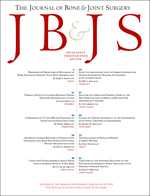JBJS Am:肩袖撕裂修复术后愈合失败不影响长期临床改善
2013-04-11 Jane译 医学论坛网
华盛顿大学医学院骨外科的一项长达10年的随访研究显示,尽管早期有结构性修复失败,但肩关节镜下肩袖巨大撕裂修复后的临床改善和疼痛缓解在长期随访中具有持久性。肩关节在与大的肩袖撕裂有关的影像学征兆上改善率高。研究者认为,对于长期满意的临床疗效来说,大的肩袖撕裂愈合情况在老年患者中不是十分重要。该论文发表在2013年4月《骨与关节外科杂志》[J Bone Joint S
华盛顿大学医学院骨外科的一项长达10年的随访研究显示,尽管早期有结构性修复失败,但肩关节镜下肩袖巨大撕裂修复后的临床改善和疼痛缓解在长期随访中具有持久性。肩关节在与大的肩袖撕裂有关的影像学征兆上改善率高。研究者认为,对于长期满意的临床疗效来说,大的肩袖撕裂愈合情况在老年患者中不是十分重要。该论文发表在2013年4月《骨与关节外科杂志》[J Bone Joint Surg Am, 2013 ;95(7):627-632v]上。
有关肩袖撕裂结构性修复失败后长期转归情况的资料很少。既往报道了一组接受关节镜下修复肩袖巨大撕裂的18例患者随访2年的临床改善结果,尽管愈合失败率为94%。该研究目的是评估这些已知肩袖撕裂修复结构性失败患者10年的结果。
83%(15/18)患者获得随访10年。采用美国肩肘外科医师(ASES)评分、简明肩关节功能测试(SST)、视觉模拟疼痛评分以及肩关节Constant评分对患者进行评估。还评估影像摄片和超声图。
到最晚随访时间时,患者平均年龄是74.6岁。平均ASES评分是79.4分(范围50~95),平均视觉模拟疼痛评分是2.2分(范围1-4分);这两种评分与2年时评分没有变化。平均SST评分是9.2分(范围6~10),校正年龄后平均Constant评分是73.2分(范围58.7~89.7)。在结构性修复失败的患者中,所有患者(除1例外)均有近端肱骨移位或肩袖损伤性关节炎的影像学征兆:3例有Hamada 2级改变,5例3级改变和3例4级改变(其中2例是4a级改变,1例为4b级改变)。超声证实2年时看到的所有撕裂伤仍持续存在。
与肩关节相关的拓展阅读:

Clinical and Radiographic Outcomes of Failed Repairs of Large or Massive Rotator Cuff Tears: Minimum Ten-Year Follow-up
INTRODUCTION
Little information exists regarding the long-term outcome after structural failure of rotator cuff repair. We previously reported clinical improvement, despite a 94% rate of failure of healing, at two years of follow-up in a cohort of eighteen patients who had undergone arthroscopic repair of massive rotator cuff tears. The purpose of the present study was to evaluate the ten-year results for these patients with known structural failures of rotator cuff repairs.
METHODS
Fifteen (83%) of eighteen patients were available for follow-up at ten years. Patients were evaluated with use of the American Shoulder and Elbow Surgeons (ASES) score, the Simple Shoulder Test (SST), a visual analog scale pain score, and the Constant score. Radiographs and sonograms were assessed.
RESULTS
The average age was 74.6 years at the time of the latest follow-up. The average ASES score was 79.4 points (range, 50 to 95 points) and the average visual analog scale pain score was 2.2 points (range, 1 to 4 points); both scores were unchanged from those at two years. The average SST score was 9.2 points (range, 6 to 12 points), and the average age-adjusted Constant score was 73.2 points (range, 58.7 to 89.7 points). Of the patients with structurally failed repairs, all but one had radiographic signs of proximal humeral migration or cuff tear arthropathy: three had Hamada Grade-2 changes, five had Grade-3 changes, and three had Grade-4 changes (with two having Grade-4a changes and one having Grade-4b changes). Ultrasound confirmed the persistence of all tears that had been seen at two years.
CONCLUSIONS
Clinical improvements and pain relief after arthroscopic rotator cuff repair of large and massive tears are durable at the time of long-term (ten-year) follow-up, despite early structural failure of repair. Shoulders had a high rate of progression of radiographic signs associated with large rotator cuff tears. These results demonstrate that healing of large rotator cuff tears is not critical for long-term satisfactory clinical results in older patients.
作者:Jane译
版权声明:
本网站所有注明“来源:梅斯医学”或“来源:MedSci原创”的文字、图片和音视频资料,版权均属于梅斯医学所有。非经授权,任何媒体、网站或个人不得转载,授权转载时须注明“来源:梅斯医学”。其它来源的文章系转载文章,本网所有转载文章系出于传递更多信息之目的,转载内容不代表本站立场。不希望被转载的媒体或个人可与我们联系,我们将立即进行删除处理。
在此留言





#修复术#
68
#JBJS#
72